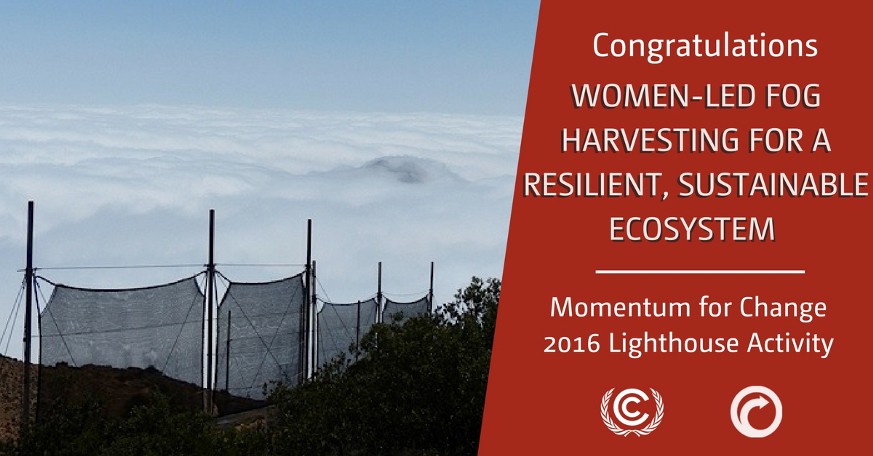Climate Innovation and the Ocean

Image: Woman-Led Fog Harvesting for a Resilient, Sustainable Ecosystem in Morocco that introduced a technological innovation inspired by ancient dew-collecting practices, providing potable water to the local community. Credit: UN Framework Convention on Climate Change
The ocean is climate. Climate is ocean. One simply cannot discuss either without the inclusion of both. That does not always occur. Often, in science, policy, and politics, they are viewed as independent entities, a reality that diffuses attention, jurisdiction, effect, and progress. In some non-governmental organizations, in the United Nations, and in some particular acts by particular governing bodies, however, a de facto integration occurs and forward movement achieved.
The United Nations Climate Change Secretariat, for example, sponsors a Movement for Change Initiative to acknowledge “Lighthouse Activities,” some of most innovative, scalable, and replicable examples of what people worldwide at every level of society are doing to address climate change and to benefit the environment, ocean and otherwise. The 2016 Awards were recently announced and, while not always directly related to the ocean, they represent many of the kinds of projects, locally and nationally, that will transform behavior in the name of climate mitigation goals, a source for optimism by virtue of successful action taken.
The thirteen awards fall into three categories: Women for Results, Financing for Climate Friendly Investment, and Information and Communications Technology. Some examples for Women for Results include “The W+ Standard” in Nepal, a rural distribution network of 1,100 women entrepreneurs facilitating access to clean energy, water, and sanitation products and services in several communities; a “Woman-Led Fog Harvesting for a Resilient, Sustainable Ecosystem” in Morocco that introduced a technological innovation inspired by ancient dew-collecting practices, providing potable water to the local community; and a “Women’s Empowerment for Resilience Against Climate Change” in Uganda, that establishes women-led groups that pool their savings into a fund from which they borrow and invest into climate-friendly, income-generating activities. Some examples for Financing for Climate Friendly Investment include “Gothenburg Green Bonds” in Sweden, the first municipal issue of bonds specifically for loans and investments that benefit the climate and the environment, and “Revenue-Neutral Carbon Tax” in British Columbia, Canada, the first in North America covering more than 70% of the provincial CO2 emissions with revenue returned to citizens in the form of personal and business tax credits and other financial measures. Examples from Information and Communications Technology Solutions include “Connected Mangroves” in Malaysia, a system the combines cloud, machine to machine, and mobile broadband to help the local community restore mangrove plantations, and “SOLshare” in Bangladesh, the world’s first technology enabled peer-to-peer trading network for rural households with or without solar home systems.
The awards will be showcased at a series of special events during the UN Climate Change Conference (@COP22 on Twitter) November 7 - 18, 2016 in Marrakesh, Morocco.
These projects are astonishingly large and small at the same time; they are first of their kind, applied in small villages and large cities, and catalyze investment, local talent, community collaboration, and exemplary implementation that can be duplicated and adapted to other places with similar circumstances. At first glance, they may seem far distant from the ocean, but not so if your remember our initial observation that the ocean and climate are synergistically entwined, that every action taken to meet the challenge of one is by definition an action to meet the challenge of the other. The global switch to solar power will reduce reliance on fossil fuels. The experiments with new forms of investment and trading will augment and change conventional finance structures and corporations that may not be as adaptable to innovation. The collection of fresh water, renewal of mangroves, the empowerment of women as agents of change within our communities – everyone of these contributes to the larger question and its answers.
Let’s be real. Will any one of them really make a difference? Absolutely. Yes. Without doubt. Individually, in each specific place; collectively, as an amalgam of possibility, real solutions, and commitment to new ideas and progress; and, internationally, as a demonstration that great things in difficult times can be achieved by the power of imagination and human will – and that is a telling expression of optimism from which we can all take heart.
- - -
This post is part of the Earth Optimism Series, 24 episodes profiling conservation actions and innovations to reduce our impacts on the planet.
The Earth Optimism Series is brought to you by the World Ocean Observatory in partnership with the Smithsonian Institution’s Ocean Portal, to raise awareness of the Global Earth Optimism Summit during Earth Day weekend, April 21st through 23rd, 2017. Share your ideas at earthoptimism.si.edu.
- Login to post comments
-


